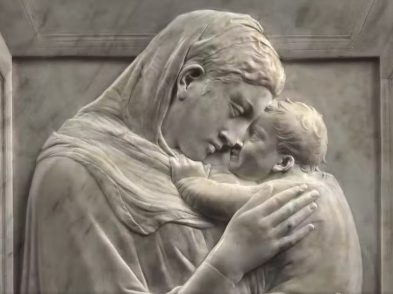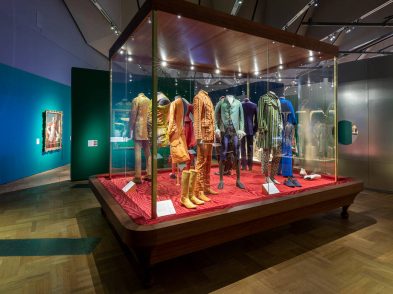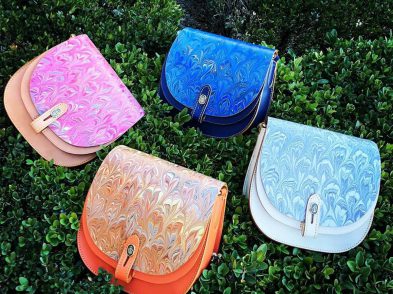In February 1951, Giovanni Battista Giorgini held Italy’s first internationally recognized fashion show at Villa Torrigiani—an event that launched a multibillion dollar industry. It was there that Sonnet Stanfill first began to assemble documents, pictures and items that are now the basis of The Glamour of Italian Fashion, 1945–2014, the exhibit at the Victoria and Albert Museum from April 5 to July 27, 2014, which she curated.

(Ferragamo and Hepburn, 1954, (c) Banca Dati dell’Archivio Foto)
‘France has Paris, but Italy has Florence,’ wrote John Fairchild, publisher of Women’s Wear Daily and a guest at the Giorgini event. ‘What I like about Florence fashion and I suppose all Italian fashion is that free spirit, ease of Italian chic, as smooth and beautiful as a Ferrari and as delicious as steaming pasta, Italian fashion is irresistible,’ he continued.
That first show, which was in Giorgini’s living room, merely hinted at things to come, as did a second successful runway at the Grand Hotel in July 1951. Three seasons later, in the Pitti Palace’s Sala Bianca, Giorgini was a triumph, heralding the dominance of Italian fashion, seducing American buyers and press.

(Fashion show in Sala Bianca, 1955, (c) Giorgini Archive, Florence)
‘Giorgini was a clever man and marketer. Here [in England] nobody knows about him, so I wanted to underline his importance and farsightedness: most documents in this exhibition come from Florence’s state archives, considered important cultural heritage since his grandson Neri Fadigati showed them to the ministry of culture in 2003, after discovering by chance 58 albums and 150 boxes full of fashion stuff in the family villa,’ said curator Stanfill.
Stanfill spent three years travelling Italy to gather materials showcasing Italian style, from the post-war couturiers of the Sala Bianca to the outstanding success of Italy’s ready-to-wear brands. She especially enjoyed browsing Florence’s Costume Gallery, the Ferragamo Foundation, Pucci, Gucci and Capucci: ‘We borrowed dresses from Palazzo Pitti, Wanda Ferragamo donated items … We also have some clips of the Sala Bianca event from Istituto Luce and many vintage pictures from Foto Locchi of Florence …We also have a section of Hollywood films shot in Rome: from there, American stars were lured to Florence and Locchi, a smart photographer, was alerted, for instance, by Ferragamo when he sold shoes to Audrey Hepburn.’
That explains why the exhibit includes Elizabeth Taylor and Richard Burton strolling along the lungarni, as well as other famous names who became ambassadors for Italian fashion, fuelling an international appetite for luxurious, Italian-made clothing.
Stanfill recalls, ‘I went to Scandicci, to the Gucci headquarters, and I was fascinated by the leather department where Florentine workers grow up with the leather knowledge handed down through generations: there you can breathe in skills and tradition in this art, which belongs to Florentine heritage.’ This is the same way in which other traditional industries have graced Italy for centuries, such as spinning, dyeing, weaving, cutting and stitching: a digital map in the exhibition will display this network, which emphasizes creativity and innovation in textiles, designs and accessories.
Florence remained the heart of Italian fashion for 15 years before it moved to Milan in the 1970s, be closer ‘to the textile manufacturing places, to industry, to the fashion press and especially to airports,’ Stanfill commented. ‘But without Giorgini, and help from the Americans behind the scene, Italian fashion might not be the powerhouse it is today; he was the lightning rod for it all.”
The designers and labels featured in this glittering exhibition include Missoni, who embodies the appeal played by Italian textile industry, along with Versace, Valentino, Ferrè, Armani, Krizia, Moschino, Prada, Fendi, Benetton, Zegna, Dolce & Gabbana and the many others who helped make the term ‘Made in Italy’ synonymous of good taste, refinement, elegance and class. This showcase of inspiration, reputation and craftsmanship of the Italian fashion industry celebrates the glamour of geniality, Italian style, reborn in Florence.








